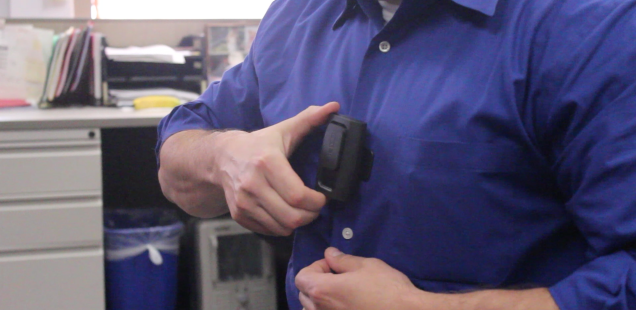Body cameras possible for local police
November 8, 2015
After law enforcement agencies around the nation were awarded a recent U.S. Justice Department grant, more police departments could be purchasing body cameras.
The Akron Police Department is one of two law enforcement agencies in Ohio who received the grant. They now join other northeast Ohio departments who have body cameras, including Cleveland, Aurora and Twinsburg.
Akron was awarded nearly $370,000 to purchase future equipment. More than $23 million in funding for body cameras was awarded to support law enforcement agencies in 32 states as part of its body-worn camera pilot plan — “a law enforcement strategy aimed at improving public safety, reducing crime and improving public trust between police and the citizens they serve.”
“This grant brings us one step closer to putting this important technology on the street on a significant scale,” said Akron Mayor Jeff Fusco in a press release.
Below is the Body-Worn Camera Pilot Implementation Program’s 2015 National Awards. Each department and city in the country who received the grant is listed below with their award amount.
While the nation has dealt with recent events including the 2014 Ferguson, Missouri, death of 18-year-old Michael Brown, the local community watched as unfolding investigation into the 2013 shooting death of James Genda, 64, who was killed during a traffic stop for pulling out an apparent handgun on a University of Akron police officer.
Officer Stephen Prough of the Akron Police Department said law enforcement agencies are looking into body cameras because of such recent events across the country and the demand for accountability and transparency due to those events.
Akron’s department has been testing body cameras since February.
Prough has had a first-hand experience in working with the body cameras that the Akron Police Department is testing and will soon purchase.
“We knew that grants were going to be forthcoming based on all the media events and as the technology (has grown). We continuously look for that technology,” Prough said.
After testing one of four cameras for 90 days at the department, he has bought one of his own to wear.
“I find it extremely useful in my profession,” Prough said. “ If someone wants to complain because they don’t like your decision, I have the video. I can say, ‘Here, sergeant, take a look at the video and you tell me if I was wrong in that situation.’”
The Akron Police Department has tested four different camera models from Taser, VIEVU and Digital Ally. They will have the chance to test another model from Wolfcom and one more brand before making their final decision later this month.
The grant poses the question of whether or not more agencies will soon look into this new technology.
Kent Police Chief Michelle Lee said there are a few factors as to why the Kent Police Department has yet to look into purchasing cameras.
“There’s not a compelling reason or… push for them, either by the offices or our department or by the community,” Lee said. “Until we come across a compelling reason to even get them… we’re kind of letting other departments… test the waters for us.”
Currently, the Kent Police Department uses in-car cruiser cameras and is looking to install a new Panasonic system once software is available.
Lee said factors such as public policy and privacy laws must be taken into consideration when a department decides to purchase body cameras. Other issues involve contact with juveniles or personal information in people’s homes.
Lee said the department will look into purchasing body cameras once there is a need from staff and community.
“Those are the issues we may have to get some clarification (on) from a law director (and will have to) see how other departments are doing (before reaching) a policy,” Lee said.
When to turn on and off the cameras may become a problem with the new technology. Also of concern is determining when footage from an incident involving a police officer and citizen would be deemed ‘public record.’
“It’s just cut down on those false complaints and false claims because when someone (claims something happened, the officer) usually knows that they did or didn’t, so it’s irrefutable when the video evidence is there,” she said.
Because not every video can be kept on file, Akron’s police department utilizes a retention schedule. If someone wants access to a video, they must get permission from the law department.
“Unfortunately though, a lot of times these videos that we’re using in incidents are evidence,” Prough said. “We don’t give out evidence to a crime until after a case has been disposed of and that can take time. Someone may become frustrated with that. We have to keep evidence in our possession until it’s done.”
Benefits of Police Cameras
While Kent’s department has not yet purchased body cameras, Lee feels there are positives.
Just as any other department, Kent’s gets its own share of officer-initiated complaints, in which evidence is needed to review those situations. The cameras would allow the footage to show exactly what occurred.
Prough has seen the use of force and officer complaints go down in Akron’s streets.
Partnership with Kent State University
The Akron Police Department is currently working with Kent State to get valuable data on the benefits of body cameras and its possible impact on police complaints and crime statistics.
“We’re giving (Kent State) the real data for not only tracking (the) use of force and complaints, but also (to look) at (the) satisfaction of the cameras by the users — the ones wearing it and the supervisors who have to deal with the back-end technology to capture that data and save it,” Prough said.
Kim Anderson and Melissa Puppo are city reporters for The Kent Stater. Contact them at [email protected] and [email protected].












